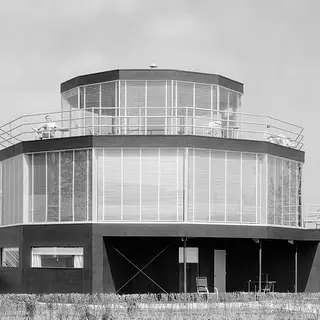
Modern Architecture
The House of Tomorrow
In the early 1930s, as America was in the grips of the Great Depression, the House of Tomorrow showed millions of World’s Fair attendees in Chicago—and people all over the world—a gleaming, technology-driven vision of what domestic life could be like in the future.
More than 39 million people attended the 1933-34 Century of Progress Exposition in Chicago, clamoring for a glimpse of the future at exhibits like the House of Tomorrow. Architect George Fred Keck’s design included many features Depression-era Americans had not seen before, such as central air conditioning and the first-ever General Electric dishwasher.
After the Fair, five Century of Progress houses were shipped by barge to Indiana where they remained in private hands until the land became part of the Indiana Dunes National Park. Despite recognition by the New York Times as an “indisputable architectural masterpiece,” the House of Tomorrow has sat vacant and deteriorating since 1999.

photo by: Indiana Landmarks
Indiana Landmarks has mothballed the House of Tomorrow to protect it while a rehabilitation plan is developed. Photo taken 2015.

photo by: Hedrich Blessing/Chicago History Museum
Architect George Fred Keck's firm designed all the modern style furniture displayed in the House of Tomorrow during the 1933-34 fair.
The National Trust and Indiana Landmarks collaborated with the National Park Service and respected architecture firms including bKL Architecture and Bauer Latoza Studio to prepare restoration plans for the House of Tomorrow. In 2023, the House of Tomorrow received a $2 million grant from the Great American Outdoors Act, funded through the U.S. Department of the Interior. Restoration of the House of Tomorrow’s exterior and concrete slab floors should begin in spring 2024, a critical first step to ensuring the long-term preservation of this innovative and unique Modern landmark.

photo by: Hedrich Blessing/Chicago History Museum
This photo shows the House during the final year of the fair in 1934.

photo by: Michael Zale
This photo shows the House starting to deteriorate in 2005.

Exterior of the House of Tomorrow at Indiana Dunes National Park. Photo taken 2015.

photo by: Michael Zale
The House of Tomorrow has been vacant since 1999, and the interior is deteriorating, as seen in this 2005 photo.
Opportunity
Once a futuristic model for residential design, the House of Tomorrow can now serve as a national model for funding the rehabilitation of historic properties in our National Parks.
Visit Indiana Dunes National Park.
PLAN YOUR VISITSupport our work to save places that matter.
Donate NowStay connected with us via email. Sign up today.
Related Stories
-
Preservation Magazine What It's Like to Live in This Indiana Midcentury Modern Residence -
Preservation Magazine Preservation Magazine's Favorite Photos from 2018 -
Preservation Magazine Edge of Tomorrow: The Unexpected Path of Five "Homes of the Future" From 1933-34
Explore More Places
Now is the time for preservation advocates to engage directly with your members of Congress and elevate the importance of historic preservation in your communities.
Get Started



